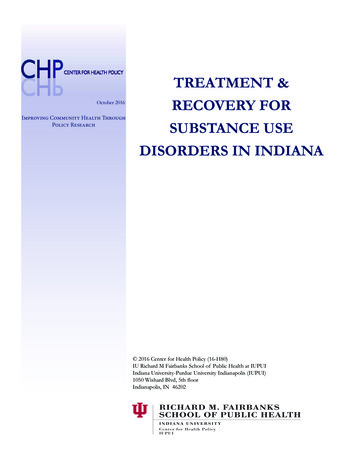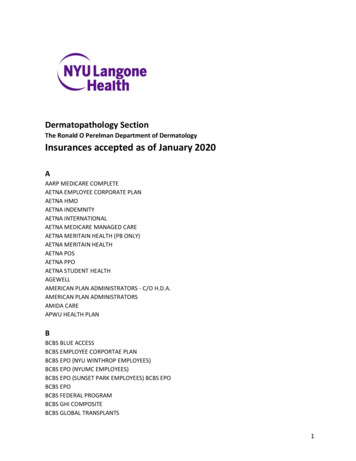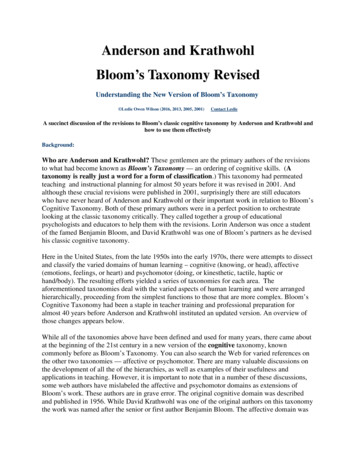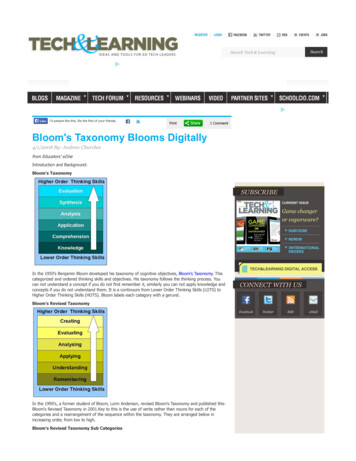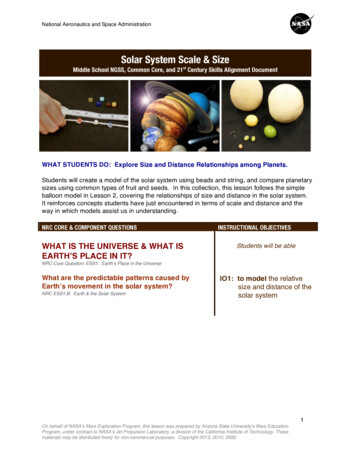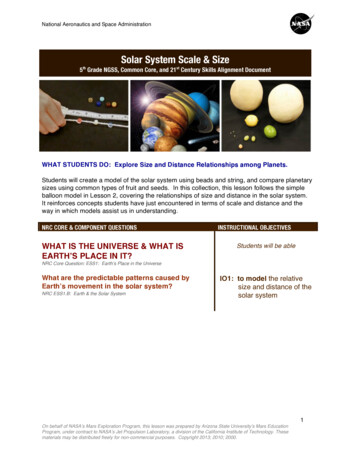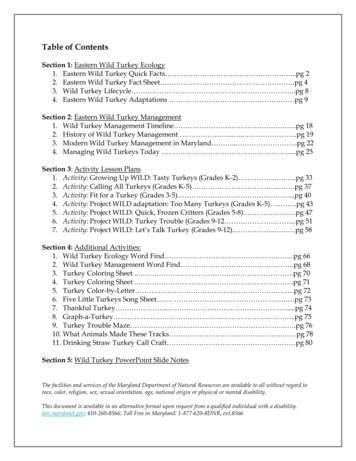
Transcription
November 2021N0 57IUPUI’s HIP Taxonomy forePortfolio: A Tool for Development,Implementation, and ScalingSusan Kahn, Tyrone Freeman, &Amy A. Powellwww.learningoutcomesassessment.org
ContentsAbstract . . . . .3Context . . . . .4HIPs at IUPUI . . . . . 5ePortfolio at IUPUI . . . . . 6NILOA MissionNational Involvement . . . . . 6The National Institute forLearning Outcomes Assessment(NILOA), established in 2008,is a research and resourcedevelopment organizationdedicated to documenting,advocating, and facilitatingthe systematic use of learningoutcomes assessment toimprove student learning.Professional Development . . . . . 7The Taxonomy: Purpose and Guiding Principles . . . . . 8The Taxonomy: Development Process . . . . . 9The Taxonomy: Organization . . . . . 10The Taxonomy: Attributes . . . . . 10Conclusion . . . . . 15Case: An ePortfolio Journey from Introduction to Integration . . . . . 15Appendix . . . . .22References . . . . . 27About the Authors . . . . .29About NILOA . . . . .30Please Cite As:Kahn, S., Freeman, T., & Powell, A. A. (2021, November). IUPUI’s HIP taxonomy forePortfolio: A tool for development, implementation, and scaling (Occasional Paper No. 57).Urbana, IL: University of Illinois and Indiana University, National Institute for LearningOutcomes Assessment (NILOA).National Institute for Learning Outcomes Assessment 2
AbstractSo-called High-Impact Practices (HIPs) are high-impact only when planned and executed thoughtfully, withattention to the relevant literature and the wisdom of experienced practitioners. After decades of experiencewith most HIPs, and national recognition for several, in 2016, IUPUI (Indiana University-Purdue UniversityIndianapolis) undertook to create a series of HIP taxonomies describing the features needed to ensure thata given HIP experience will be truly high-impact. In 2018-2019, a committee of IUPUI HIPs and ePortfoliopractitioners and experts convened to develop a similar taxonomy for ePortfolio, the most recently recognizedHIP and one with which IUPUI already had nearly two decades of experience. In this Occasional Paper, wediscuss the history of ePortfolio at IUPUI and what we came to understand about effective ePortfolio practice;the purposes of the taxonomies and of the ePortfolio taxonomy in particular; the development processfor the taxonomy; our use of the ePortfolio taxonomy for professional development; and the attributes ofhigh-impact ePortfolio practice that we identified, based on the growing literature on ePortfolio and on ourcampus and individual experiences. In the taxonomy and this paper, we emphasize the need for ePortfolioto be central to curricular design; embedded in pedagogies that support integrative learning and identitydevelopment; developed in concert with explicit instruction on “ePortfolio making”; and assessed holisticallyand in alignment with desired learning outcomes and experiences. The paper concludes with a case studyfrom IUPUI’s Philanthropic Studies B.A. program, which discovered through its own ePortfolio work manyof the same principles and practices reflected in the taxonomy and the literature.National Institute for Learning Outcomes Assessment 3
IUPUI’s HIP Taxonomy for ePortfolio:A Tool for Development, Implementation, and ScalingContextElectronic student portfolio practitioners and researchers were thrilled when George Kuhrecognized ePortfolio as a High-Impact Practice (HIP), based on the evidence presentedby Bret Eynon and Laura Gambino in their 2017 book, High-Impact ePortfolio Practice:A Catalyst for Student, Faculty, and Institutional Learning. In the volume’s foreword, Kuhagrees that Eynon and Gambino’s evidence, based on a 26-institution national project,Empirically demonstrated that, when done well, students who create and continueto add to their ePortfolio as intended benefit in ways similar to students whoparticipate in one or more of the 10 HIPs on the AAC&U [Association of AmericanColleges & Universities] list. That is, compared with their counterparts who didnot use ePortfolios, students taking courses requiring ePortfolios were generallymore engaged in educationally purposeful activities, earned higher grades, andwere more likely to complete courses and persist.The scope and complexity of theeffort [in the national project] are impressive and the pattern of positive findingsis consistent enough to substantiate the claim that the ePortfolio—when donewell—warrants joining the AAC&U HIPs list. (Kuh, 2017, p. viii; italics added)As an early adopter and leadingproponent of many of thesepractices, including ePortfolio,IUPUI has long understoodthe importance of doing thesepractices well—that is, withfidelity to the key features thatmake each HIP “high-impact”and with any adaptationsneeded to meet the needs of thelearners in question.Leading higher education organizations like AAC&U and NILOA quickly followedKuh’s lead, adding ePortfolio to the list of ten HIPs that Kuh had initially identifiedin his 2008 monograph, High-Impact Educational Practices: What They Are, WhoHas Access to Them, and Why They Matter. This recognition of the pedagogical powerof ePortfolio confirmed what many of us working with them (e.g., Bass, 2009, p. 35;Cambridge, 2010; Cambridge, Cambridge, & Yancey, 2009; Eynon & Gambino,2017, 2018; Kahn, 2019b; Reynolds & Patton, 2014; Yancey, 2019) had longobserved: That ePortfolio, like other HIPs, could intensify and deepen the impactof students’ educational experiences, making their learning more meaningful,powerful, and connected, and enhancing their intellectual and personal development.ePortfolio scholars and advanced practitioners also recognized the importance of Kuh’scaveat; ePortfolio needed to be “done well” to have the powerful impact documented byEynon and Gambino and their colleagues. The same caveat applies to all of the eleven HIPsidentified so far. As an early adopter and leading proponent of many of these practices,including ePortfolio, IUPUI has long understood the importance of doing these practiceswell—that is, with fidelity to the key features that make each HIP “high-impact” and withany adaptations needed to meet the needs of the learners in question. In 2015, inspired by anAssessment Institute presentation by Ken O’Donnell (2014) of California State University,Dominguez Hills, on a similar project, IUPUI began developing “Engaged Learningtaxonomies” describing the features of “done well” practice in the IUPUI context for (sofar) ten HIPs. The campus-wide project aimed to clearly and concisely define the design andimplementation characteristics needed to ensure effective use of these practices at IUPUI.The first set of HIP taxonomies was completed in 2016, with additional taxonomies,including the ePortfolio taxonomy, developed in subsequent years. The current set ofNational Institute for Learning Outcomes Assessment 4
ten taxonomies can be found at his article focuses on the development and key features of the ePortfolio taxonomy,and includes a case study from IUPUI’s B.A. program in Philanthropic Studies. Overthe course of more than ten years working with ePortfolio, Philanthropic Studiesdiscovered from experience many of the attributes of high-impact practice representedin the taxonomy, which we include here as an appendix. But we begin with someadditional background on HIPs at IUPUI and on our campus ePortfolio initiative.HIPs at IUPUIIUPUI’s first mission documents, developed shortly after the campus commencedoperations in 1969, pledged to raise educational attainment in Indianapolis,central Indiana, and the entire state, using teaching and learning strategies whoseeffectiveness was demonstrated by evidence (Kahn & Scott, 2013, para. 8). By thelate 1980s, IUPUI had become an early adopter of assessment, and by the late 1990s,the campus was nationally recognized for its leadership on freshman seminars, firstyear experiences, learning communities, and service learning, programs that wereiteratively adjusted and refined over the years based on evidence from assessment.During this period and in the early 2000s, smaller, but growing, numbers of studentswere also participating in mentored undergraduate research and study abroad.In 2008, a new academic plan provided additional investment in and scalingopportunities for “signature” IUPUI pedagogies encompassed by the RISE (Research,International, Service, and Experiential) to the IUPUI Challenge Initiative (IUPUIDivision of Academic Affairs, 2008, p. 8). RISE encouraged all undergraduatestudents to experience at least two of these active-learning pedagogies, providingscholarships for participation and expanding professional development opportunitiesfor faculty and staff leading these activities. The initiative gained additional impetuslater in the year, when all four experiences were recognized as HIPs (Kuh, 2008).A 2014 IUPUI strategic plan emphasizing student learning, engagement, and successfurther broadened opportunities for students to participate in HIPs. With continuedgrowth of dedicated scholarships for experiences like study abroad and service learningand increasing numbers of faculty and staff incorporating HIPs into their own programs,IUPUI leadership created the Institute for Engaged Learning (IEL) in 2018 to bring HIPs oncampus under one organizational umbrella. The Institute integrates previously separate unitsresponsible for service learning, internships, undergraduate research, first-year experiences,and, now, ePortfolio, with the aim of providing equitable access to HIPs and bringingnew knowledge to bear on HIPs implementation. Setting a high bar for participation, IELcurrently aims for all students to participate in at least four HIPs as they progress alonga coherent engaged learning pathway, with ePortfolio supporting continuity, integration,reflection, and identity-building throughout students’ undergraduate experiences.By 2015, IUPUI was thus well-positioned to create and refine HIPs taxonomies tosupport professional development and further capacity-building efforts to ensure thatHIPs were implemented knowledgeably and effectively, even as implementation wasscaled up. Communities of Practice, for example, provided faculty and staff opportunitiesto explore, implement, and reflect on their experiences with these pedagogies, aligningtheir courses and programs to the developing taxonomies and refining and modifying theNational Institute for Learning Outcomes Assessment 5
taxonomies when appropriate. To date, the taxonomies have provided invaluable supportfor professional development and scaling of “done well” HIPs planning and practice.ePortfolio at IUPUIThe ePortfolio initiative at IUPUI began in the early 2000s, but gained real tractionaround 2010, when improved software made large-scale use more feasible andacquired the ability for students to create ePortfolio websites containing their workand reflections in various media (Kahn & Scott, 2014). The latter capability sparkedrenewed interest, and adoption by departments and programs accelerated. Indeed,the ability to represent oneself and one’s learning and to create a digital academic/professional presence on the internet is essential to the high impact of ePortfolioexperiences done well (Cambridge, 2010; Cambridge, Cambridge, & Yancey,2008; Eynon & Gambino, 2017, 2018; Kahn, 2019a, 2019b; Yancey, 2019).The largest program to adopt ePortfolio at this time was the first-year seminar inUniversity College, which began requiring students in selected sections to develop anePortfolio-based Personal Development Plan, or ePDP (Buyarski & Landis, 2014).In 2010-2011, when University College initially piloted the ePDP, a small groupof faculty volunteers engaged in an intensive two-week professional developmentprogram focused largely on reflection and related pedagogies. Students in sectionstaught by those faculty members had significantly higher first-year GPAs andfirst-to-second-semester retention rates than students in non-ePDP sections.IUPUI became involved inseveral national ePortfolioinitiatives focused onresearching the ways inwhich ePortfolio couldmost effectively deepen andstrengthen student learningand achievement.But University College lacked the resources to offer a similar intensive professionaldevelopment experience to the many faculty members who adopted the ePDP in subsequentyears, and the student success results from the pilot year were not consistently sustained(Buyarski, 2016). This development was congruent with findings at other universitiesthat also demonstrated more powerful outcomes from ePortfolio when faculty and staffparticipated in extended intensive professional development than when they engagedin brief training programs or no professional development. (See, for example, GetmanEraso & Culkin, 2018.) This phenomenon underlines the importance of informed andthoughtful—done well—ePortfolio implementation to the impact of ePortfolio onstudent learning and success. The taxonomy is intended, in part, to address this need.National InvolvementAround this time, IUPUI became involved in several national ePortfolio initiativesfocused on researching the ways in which ePortfolio could most effectively deepen andstrengthen student learning and achievement. In Cohort VI of the Inter/national Coalitionfor Electronic Portfolio Research, teams from 14 institutions of several types exploredePortfolio reflection, composition, and assessment in depth (Cambridge, Cambridge, &Yancey, 2009). As part of IUPUI’S participation, our project team conducted researchon reflection pedagogies across IUPUI courses and programs using ePortfolio. We foundsignificant diversity of pedagogical practices around reflection and even among definitionsof reflection, with some instructors seeing reflection as expression of opinion or feelingsand others defining it as a more rigorous process of examining learning experiences andconcepts, often in relation to one another. Assessment practices followed suit; whenreflection was treated as opinion or emotional expression, it was less likely to be assessed thanNational Institute for Learning Outcomes Assessment 6
when it was thought of as a meaningful intellectual exercise (Landis, Scott, & Kahn, 2015).Another national initiative, the Connect to Learning project led by Eynon and Gambino,included 26 institutional teams representing all U.S. higher education sectors. This projectengaged participating institutions in developing a model for high-impact ePortfoliopractice that incorporated pedagogical, technological, professional development, outcomesassessment, and scaling aspects of ePortfolio implementation (Eynon & Gambino, 2017).Participating institutions used a common annual student survey and other common datagathering activities, wrote about various aspects of their campus practices with ePortfolio,engaged in frequent online discussion and commentary about their own and oneanother’s work, and carried out individual campus projects. (The project website, Catalystfor Learning: ePortfolio Resources and Research, contains much of this material, includingmultiple essays and examples from each participating campus.) IUPUI’s project for thisinitiative focused on improving and expanding implementation of the ePDP in the firstyear seminar and piloting continuation of the ePDP in both academic and co-curricularprograms taken after the first-year seminar. Connect to Learning resulted in the High-ImpactePortfolio Practice volume that convinced Kuh and others to recognize ePortfolio as a HIP.These projects got underway at a time when interest in ePortfolio and its potential tosupport powerful new learning was surging at IUPUI and across higher education morebroadly. A national ePortfolio organization, the Association for Authentic, Experiential,and Evidence-Based Learning (AAEEBL), was founded in 2009 and offered its first annualconference in 2010. IUPUI has participated extensively in AAEEBL, with dozens offaculty and staff presenting at AAEEBL regional, national, and international conferencesand serving on AAEEBL committees. The International Journal of ePortfolio (IJEP), anonline, peer-reviewed journal, published its first issue in 2011, and has nurtured thedevelopment of a substantial research literature on ePortfolio. Several IUPUI faculty andstaff members have been involved in IJEP as authors or reviewers. IUPUI has also been aconsistent contributor to the AAC&U ePortfolio Forum, which began in the mid-2000s,and, as we write, has several teams participating in AAC&U’s inaugural ePortfolio Institute.Professional DevelopmentIUPUI’s involvement in all of the above initiatives during the early and mid-2010s helpeddevelop a corps of faculty and staff experts in ePortfolio pedagogy and implementation. Inaddition, a new university-wide general education program; the recognition of ePortfolioas a high-impact practice; the inclusion of ePortfolio in the campus’s new Institute forEngaged Learning; and the taxonomy all boosted interest in ePortfolio at IUPUI, and set thestage for broadening and deepening ePortfolio adoption and practice across the university.Following the development of the taxonomy and the ePortfolio’s move to the Institute forEngaged Learning, the initiative renewed its focus on professional development and scalingePortfolio implementation across the curriculum and co-curriculum. Our rich array ofprofessional development opportunities includes consultations, workshops, Communitiesof Practice, project grants, and funding for participation in national conferences. Weapproach professional development with a longitudinal lens; increasing the impact ofePortfolio requires the coordination and development of groups of faculty and staff,working with intentionality over a period of time. The attributes we present here take timeand experience to develop. As buy-in for ePortfolio shifts from a single faculty memberNational Institute for Learning Outcomes Assessment 7
in a program, to a group of faculty, to a program-wide or departmental commitment tointegrate ePortfolio across a degree program or set of co-curricular experiences, professionaldevelopment is also iterative and seeks to address the needs of each phase of growth.Most recently, a new ePortfolio Community of Practice has examined each of theattributes of high-impact practice outlined in the taxonomy. These activities havecontinued online through the COVID-19 pandemic. Another faculty-led Communityof Practice, focused on capstone experiences, became a forum for exploring howePortfolio could support key capstone goals: integrating learning across experiences andover time; reflecting on growth of personal, academic, civic, and professional identity;completing a substantive project; and sharing learning publicly. Because the ePortfoliotaxonomy provides clear guidance and successively scaled levels of adoption, from singlecourses to whole programs and institutions, capstone instructors found pathways fordegree programs to extend ePortfolio from capstones across entire program curricula.Finally, the COVID-19 pandemic has sparked new interest in ePortfolio. Our EngagedLearning Showcase, an annual campus showcase of student participation in various engagedlearning programs and projects, was moved online in 2020 and 2021, and many studentscreated ePortfolios to share their projects. Faculty and staff often become interested inadopting ePortfolios when they see examples of them, and that was the case in the last two years.Increased adoption of ePortfolio across curricular and co-curricular programs madeclearer a longstanding need for one-to-one student support in developing ePortfoliomaking skills. This year, a peer-led ePortfolio Studio was created as a dedicated campusspace where students could work with a peer mentor on creating and refining theirePortfolios and getting feedback. The Studio provides some technical support, but themain focus is on ePortfolio making skills like design, structure, aesthetics, understandingof audience, cohesiveness, and multi-modal communication. The Studio sets the stagefor further growth of ePortfolio use across the campus—and continued use of theePortfolio Taxonomy to help prepare and guide faculty and staff new to ePortfolio.IUPUI’s ePortfolio taxonomy has thefollowing purposes:1. Part of a larger campus projectto develop taxonomies for all 11HIPs to define and encourage“done well” HIP practice;2. Provides a framework forprofessional development offaculty and staff with varyinglevels of ePortfolio experience;3. Intended to offer faculty andstaff ongoing guidance onePortfolio course, program, orother experience design andimplementation.The Taxonomy: Purpose and Guiding PrinciplesThe ePortfolio taxonomy has several purposes. As we have noted, it is part of a largercampus project to develop taxonomies for all 11 HIPs, in order to define and encourage“done well” HIP practice that can guide implementation at IUPUI. The taxonomy alsoprovides a framework for professional development of faculty and staff with varying levelsof experience with ePortfolio. Finally, it is intended to offer faculty and staff ongoingguidance on ePortfolio course, program, or other experience design and implementationto ensure that they are creating meaningful and powerful student learning experiences.The taxonomy approaches high-impact practice “aspirationally,” so that impactincreases as adoption is scaled up, from a single course or experience, to coursesequences, to degree programs, and, finally, to the whole undergraduate experience.In general, the more students work with ePortfolio, carefully planned and done well,the more impact it will have. Still, individual instructors can implement elements ofhigher- and highest-impact practice and programs can implement many aspectsof “highest-impact practice,” as we see in the Philanthropic Studies case study.National Institute for Learning Outcomes Assessment 8
In practice, at IUPUI, most instances of ePortfolio adoption have begun with a singlecourse, often a capstone. Use of the portfolio then often spreads to courses in theprogram or sequence that students take prior to the capstone, as it did in PhilanthropicStudies. The taxonomy is designed to support entry into ePortfolio work at any level,allowing individuals or small groups to increase the depth and breadth of their practiceover time. As ePortfolio activities expand across courses and programs, however,professional development needs change; intentional coordination among facultybecomes increasingly important to the cohesiveness of students’ learning experiences andePortfolio composition and may benefit from guidance by professional development staff.The Taxonomy: Development ProcessThe taxonomy was created by a working group of campus faculty and staff representingthe many different contexts and ways in which ePortfolio is used at IUPUI: directors ofacademic and co-curricular programs (including leaders of HIP experiences); experiencedfaculty practitioners from a range of disciplines: assessment specialists; academic andcareer advising staff; instructional technology staff; and diversity, equity, and inclusionleaders. The working group was charged with creating a HIP taxonomy for ePortfolioto guide faculty and staff in planning and implementing ePortfolio in courses, academicprograms, and co-curricular programs, especially programs focused on other HIPs. Thecharge also instructed the group to offer direction for professional development aimed atencouraging thoughtful and informed implementation of ePortfolio at IUPUI. Taxonomydevelopment took place over one academic year, with ongoing review and revision asthe taxonomy was implemented. The full contributing group included thirteen facultyand staff, with a writing group of three (these authors) who co-authored the taxonomy.Taxonomy development took place in several phases:1. Gathering input from the full group, based on a literature review and our ownexperiences with ePortfolio. During this collaborative process, a list of attributes ofeffective ePortfolio practice was developed and reduced to a summary of essentialelements.2. Drafting the taxonomy. This task was carried out by the three-person writing team.3. Soliciting and incorporating feedback from the full group on the initial taxonomydraft and rewriting/editing to create a pilot draft.4. Disseminating the pilot draft, requesting feedback via survey, and revising, based onthe feedback.Certain key elements enabled us to include a large group of contributors, while completingthe task within a short time: A clear charge from leadership: Create a taxonomy useful to our context at IUPUI.This resulted in a taxonomy relevant to IUPUI, but potentially transferable to otherinstitutions. A clear audience for the document: IUPUI faculty and staff. This helped us focus theproject. A well-defined timeline: Our conversations could have continued for much longer,but the timeline forced us to keep moving forward. A broad range of perspectives among members of the working group. We wantedthe taxonomy to be useful to a wide range of campus ePortfolio stakeholders, so weneeded multiple voices at the table.National Institute for Learning Outcomes Assessment 9
A small writing team with extensive ePortfolio experience. This helped to ensureefficiency and productivity.The opportunity for all campus practitioners to offer feedback. The pilot taxonomywas sent to the campus ePortfolio listserv (1600 subscribers), along with a feedbackform.The writing team also sought external feedback from peers in the field duringpresentations of the taxonomy at AAC&U’s ePortfolio Forum, AAEEBL’s nationalconference, and the Assessment Institute in Indianapolis.The Taxonomy: OrganizationThe taxonomy is intended as a brief, concise summary of the key attributes of ePortfolio,done well, at the undergraduate level. (The attributes apply to graduate/professionallearning too, but some language refers specifically to the undergraduate experience.)It opens with a description of ePortfolio as a framework for learning and a space forstudents to create new knowledge by integrating learning, understanding their educationas a meaningful learning pathway, and developing academic and professional identitiesthat can be represented and managed online.1.The taxonomy is intended as abrief, concise summary of thekey attributes of ePortfolio,done well, at the undergraduatelevel.Like much of the taxonomy itself, the description draws on Yancey’s comparison ofePortfolios that function as “wrappers” of learning to “ePortfolio as Curriculum” (Yancey,2019, pp. 2-4). In the former, ePortfolios are containers of evidence of learning representedby the artifacts therein. “ePortfolio as Curriculum” on the other hand, sees ePortfolio makingitself as a learning experience—ideally, a high-impact one. The ePortfolio, in this view, is notjust a collection, but a composition, unified by a reflective text that explains the individualand collective meanings of the artifacts it includes (Yancey, 2004). All of what follows inthe taxonomy, including the attributes of high-, higher-, and highest-impact ePortfoliopractice, rests on the idea that ePortfolio, done well, is a vehicle for and artifact of a HIP.Following the description, we added a condensed statement of the purpose of the taxonomy.We further explain that each attribute is described along three levels of impact—high, higher,and highest. Here, we followed the template laid out by the ten previous taxonomies in avoidingany mention of “low-impact” practice. One can insert a “not” or “do not” in each of our fourattributes of high-impact practice to understand what low-impact practice might look like.Along the side of the first page, we include very brief descriptions of the taxonomy initiativeand of the “Pathways Portfolio” that we aspire for IUPUI programs and the campusto adopt—an undergraduate portfolio that supports and integrates learning as studentsprogress along a learning pathway in a meaningful sequence of experiences to graduation.The second page provides a short glossary of terms used in the taxonomy descriptors,and shows how the descriptors align with our campus general education outcomes, theProfiles of Learning for Undergraduate Success, known as “PLUS” or “the Profiles.” Thelatter section is followed by the taxonomy itself.The Taxonomy: AttributesNow we come to the crux of the taxonomy: the key attributes of high-impact ePortfolioNational Institute for Learning Outcomes Assessment 10
practice and the successive levels of impact we identified, based on our readings, discussions,and teaching experiences with ePortfolio. This part of the taxonomy is presented in tableformat, with rows representing key attributes or aspects of practice and columns representinglevels of impact. Each level of impact includes several bulleted descriptors or characteristicsof the attribute in that row. To economize on space, we decided that each level of impactwould incorporate all the characteristics of the previous levels, so that “higher-impact”practice includes the characteristics of “high-impact” practice, and “highest-impact”practice includes the characteristics of both “high-impact” and “higher-impact” ePortfolios.We identified the following attributes of high-impact ePortfolio practice:1. ePortfolio is central to the curricular design of the course, program, or universityexperience.As is the case with other HIPs, ePortfolio will be “high-impact” only when thoughtfullyembedded in an intentional learning design, whether within the formal curriculumor in a co-curricular experience. An early and painful lesson learned at IUPUI andother institutions is that poor curricular integration and uninformed pedagogy willresult in minimal impact of ePortfolios, as many studies and ePortfolio initiativesover the past 20 years have found (e.g.,
The ePortfolio initiative at IUPUI began in the early 2000s, but gained real traction around 2010, when improved software made large-scale use more feasible and acquired the ability for students to create ePortfolio websites containing their work and reflections in various media (Kahn & Scott, 2014). The latter capability sparked
